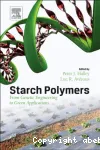| Titre : |
Starch polymers : from genetic engineering to green applications |
| Type de document : |
texte imprimé |
| Auteurs : |
Peter. J Halley |
| Editeur : |
Amsterdam : Elsevier |
| Année de publication : |
2014 |
| Importance : |
1 vol. (xxi-461 p.) |
| Présentation : |
ill., couv. ill. en coul. |
| Format : |
24 cm |
| ISBN/ISSN/EAN : |
978-0-444-53730-0 |
| Index. décimale : |
668.9 Polymères |
| Résumé : |
"This book focuses on starch polymers including starch genetics, biotechnological and chemical modification, nanostructures, processing, characterization, properties and applications. This books topic is in a cutting edge and emerging technology area of biomaterials, nanomaterials and renewable materials, and will involve international experts in diverse fields from genetic engineering to applications." |
| Note de contenu : |
1. INTRODUCTION
1.1. Starch polymers – from the field to industrial products (Peter Halley, and Luc Averous)
2. STARCH GENETICS
2.1. Genetically modified starch: state of art and perspectives (Matthew Morell)
2.2. Structure-properties relationships for genetically modified starch (Peter Halley, and Ihwa Tan)
3. NOVEL STARCH MODIFIED BY BIOTECHNOLOGY
3.1. Starch modification by biotechnology: state of art and perspectives (Richard G.F. Visser, and Luisa Trindade)
3.2. The Application of Enzymes Involved in Starch Derivatization: some Recent Developments (Carmen Boeriu)
4. NOVEL STARCH MODIFIED BY CHEMISTRY
4.1. Chemically modified Starch to develop novel materials: state of art and perspectives (Ken Mcnaught)
4.2.Starch modification (Atanu Biswas, and J.L.Willett)
5. STRUCTURES AND PROPERTIES OF NOVEL STARCH-BASED MATERIALS
5.1. Structure-Properties of Starch-based blends and micro/nanocomposites: state of art and perspectives (Rowan Truss, Celine Chaleat, and Peter Halley)
5.2. Nano-biocomposites based on plasticized starch: state of art and perspectives (Luc Averous, and Eric Pollet)
5.3. Processing and long term properties of starch polymers and blends (Fengwei Xie, Rowan Truss, Peter Halley, and Celine Chaleat)
6.NOVEL CHARACTERISATION METHODS
6.1. Characterization methods for starch-based materials: state of art and perspectives (Robert Gilbert)
6.2.Starch NMR (Mike Gidley)
7. NOVEL PROCESSING
7.1. Processing of Plasticized starch-based materials: state of art and perspectives (Long Yu, Fengwei Xie, and Peng Liu)
7.2. Reactive extrusion for thermoplastic starch polymer blends (Peter Halley, and Raju Maliger)
8. DEGRADATION AND BIODEGRADATION
8.1. Degradation and biodegradation standards for starch-based materials (Joe Greene)
8.2. Effect of the formulation, structure and processing on biodegradation (Katherine Dean)
9. APPLICATIONS
9.1. Starch applications: state of market and new trends (Peter Halley, and Bronwyn Laycock)
9.2. Starch plastics packaging and agricultural applications (Greg Glenn, Syed H. Imam, William J. Orts, and Bor-Sen Chiou)
9.3. Water resistant thermoplastics starch polymer applications (Ann Roberts, Nick Mccaffrey, and Celine Chaleat) |
Starch polymers : from genetic engineering to green applications [texte imprimé] / Peter. J Halley . - Amsterdam : Elsevier, 2014 . - 1 vol. (xxi-461 p.) : ill., couv. ill. en coul. ; 24 cm. ISBN : 978-0-444-53730-0
| Index. décimale : |
668.9 Polymères |
| Résumé : |
"This book focuses on starch polymers including starch genetics, biotechnological and chemical modification, nanostructures, processing, characterization, properties and applications. This books topic is in a cutting edge and emerging technology area of biomaterials, nanomaterials and renewable materials, and will involve international experts in diverse fields from genetic engineering to applications." |
| Note de contenu : |
1. INTRODUCTION
1.1. Starch polymers – from the field to industrial products (Peter Halley, and Luc Averous)
2. STARCH GENETICS
2.1. Genetically modified starch: state of art and perspectives (Matthew Morell)
2.2. Structure-properties relationships for genetically modified starch (Peter Halley, and Ihwa Tan)
3. NOVEL STARCH MODIFIED BY BIOTECHNOLOGY
3.1. Starch modification by biotechnology: state of art and perspectives (Richard G.F. Visser, and Luisa Trindade)
3.2. The Application of Enzymes Involved in Starch Derivatization: some Recent Developments (Carmen Boeriu)
4. NOVEL STARCH MODIFIED BY CHEMISTRY
4.1. Chemically modified Starch to develop novel materials: state of art and perspectives (Ken Mcnaught)
4.2.Starch modification (Atanu Biswas, and J.L.Willett)
5. STRUCTURES AND PROPERTIES OF NOVEL STARCH-BASED MATERIALS
5.1. Structure-Properties of Starch-based blends and micro/nanocomposites: state of art and perspectives (Rowan Truss, Celine Chaleat, and Peter Halley)
5.2. Nano-biocomposites based on plasticized starch: state of art and perspectives (Luc Averous, and Eric Pollet)
5.3. Processing and long term properties of starch polymers and blends (Fengwei Xie, Rowan Truss, Peter Halley, and Celine Chaleat)
6.NOVEL CHARACTERISATION METHODS
6.1. Characterization methods for starch-based materials: state of art and perspectives (Robert Gilbert)
6.2.Starch NMR (Mike Gidley)
7. NOVEL PROCESSING
7.1. Processing of Plasticized starch-based materials: state of art and perspectives (Long Yu, Fengwei Xie, and Peng Liu)
7.2. Reactive extrusion for thermoplastic starch polymer blends (Peter Halley, and Raju Maliger)
8. DEGRADATION AND BIODEGRADATION
8.1. Degradation and biodegradation standards for starch-based materials (Joe Greene)
8.2. Effect of the formulation, structure and processing on biodegradation (Katherine Dean)
9. APPLICATIONS
9.1. Starch applications: state of market and new trends (Peter Halley, and Bronwyn Laycock)
9.2. Starch plastics packaging and agricultural applications (Greg Glenn, Syed H. Imam, William J. Orts, and Bor-Sen Chiou)
9.3. Water resistant thermoplastics starch polymer applications (Ann Roberts, Nick Mccaffrey, and Celine Chaleat) |
|  |


